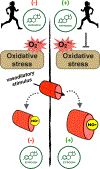Aerobic exercise training and vascular function with ageing in healthy men and women
- PMID: 31077372
- PMCID: PMC6773490
- DOI: 10.1113/JP277764
Aerobic exercise training and vascular function with ageing in healthy men and women
Abstract
Cardiovascular diseases (CVD) remain the leading cause of morbidity and mortality in both men and women in developed societies. Age is the greatest risk factor for CVD due largely to adverse changes to arteries that include stiffening of the large elastic arteries (aortic and carotid arteries) and endothelial dysfunction. Vascular ageing is driven by oxidative stress, which reduces nitric oxide (NO) bioavailability and stimulates changes in the extracellular matrix. In women, reductions in circulating oestrogens with menopause interact with ageing processes to induce vascular dysfunction. Regular aerobic exercise is the most evidence-based strategy for reducing CVD risk with ageing in both men and women. Much of this cardiovascular-protective effect of aerobic exercise is likely due to its vascular health-enhancing influence. Large elastic artery stiffening with advancing age is attenuated in healthy adults engaged in aerobic exercise training, and aerobic exercise interventions improve arterial stiffness in previously sedentary middle-aged and older men and postmenopausal women. Regular aerobic exercise also enhances endothelial function with ageing in men (by reducing oxidative stress and preserving NO bioavailability), but not consistently in oestrogen-deficient postmenopausal women. In postmenopausal women, treatment with oestradiol appears to restore the ability of aerobic exercise to improve NO-mediated endothelial function by reducing oxidative stress. Several research gaps exist in our understanding of potential sex differences in the vascular adaptations to regular aerobic exercise. More information is needed on the factors that are responsible for sex differences, including the role of circulating oestrogens in transducing the aerobic exercise training 'stimulus'.
Keywords: arterial stiffness; endothelial function; estrogen; oxidative stress.
© 2019 The Authors. The Journal of Physiology © 2019 The Physiological Society.
Figures






References
-
- Akazawa N, Choi Y, Miyaki A, Tanabe Y, Sugawara J, Ajisaka R & Maeda S. (2012). Curcumin ingestion and exercise training improve vascular endothelial function in postmenopausal women. Nutr Res 32, 795–799. - PubMed
-
- Benjamin EJ, Virani SS, Callaway CW, Chamberlain AM, Chang AR, Cheng S, Chiuve SE, Cushman M, Delling FN, Deo R, Ferranti SDd Ferguson JF, Fornage M, Gillespie C, Isasi CR, Jiménez MC, Jordan LC, Judd SE, Lackland D, Lichtman JH, Lisabeth L, Liu S, Longenecker CT, Lutsey PL, Mackey JS, Matchar DB, Matsushita K, Mussolino ME, Nasir K, O’Flaherty M, Palaniappan LP, Pandey A, Pandey DK, Reeves MJ, Ritchey MD, Rodriguez CJ, Roth GA, Rosamond WD, Sampson UKA, Satou GM, Shah SH, Spartano NL, Tirschwell DL, Tsao CW, Voeks JH, Willey JZ, Wilkins JT, Wu JH, Alger HM, Wong SS & Muntner P. (2018). Heart Disease and Stroke Statistics-2018 Update: A Report From the American Heart Association. Circulation 137, e67–e492. - PubMed
-
- As Bjørnerem, Straume B, Midtby M, Fønnebø V, Sundsfjord J, Svartberg J, Acharya G, Øian Pl & Berntsen GKR. (2004). Endogenous Sex Hormones in Relation to Age, Sex, Lifestyle Factors, and Chronic Diseases in a General Population: The Tromsø Study. The Journal of Clinical Endocrinology & Metabolism 89, 6039–6047. - PubMed
-
- Casey D, Pierce G, Howe K, Mering M & Braith R. (2007). Effect of resistance training on arterial wave reflection and brachial artery reactivity in normotensive postmenopausal women. Eur J Appl Physiol 100, 403–408. - PubMed
Publication types
MeSH terms
Grants and funding
- R01 HL107120/HL/NHLBI NIH HHS/United States
- R01 AG049762/AG/NIA NIH HHS/United States
- R01 AG027678/AG/NIA NIH HHS/United States
- R21 AG042795/AG/NIA NIH HHS/United States
- R01 AG019339/AG/NIA NIH HHS/United States
- R56 HL114073/HL/NHLBI NIH HHS/United States
- R01 AG013038/AG/NIA NIH HHS/United States
- R21 HL107105/HL/NHLBI NIH HHS/United States
- M01 RR000051/RR/NCRR NIH HHS/United States
- R21 AG049451/AG/NIA NIH HHS/United States
- T32 AG000279/AG/NIA NIH HHS/United States
- R37 AG013038/AG/NIA NIH HHS/United States
- K01 AG020683/AG/NIA NIH HHS/United States
- R01 AG006537/AG/NIA NIH HHS/United States
- UL1 TR001082/TR/NCATS NIH HHS/United States
- R01 HL134887/HL/NHLBI NIH HHS/United States

